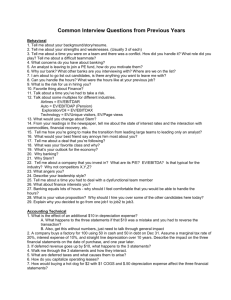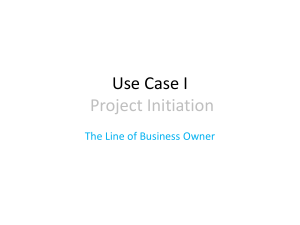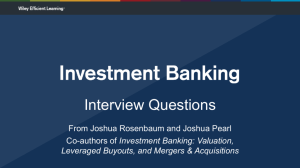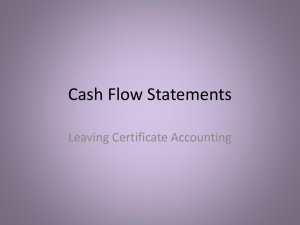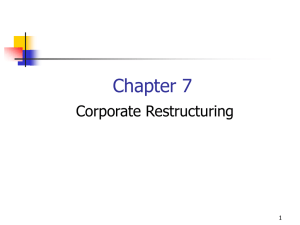EBITDA And Leveraged Buyouts (LBO) For The Trade
advertisement
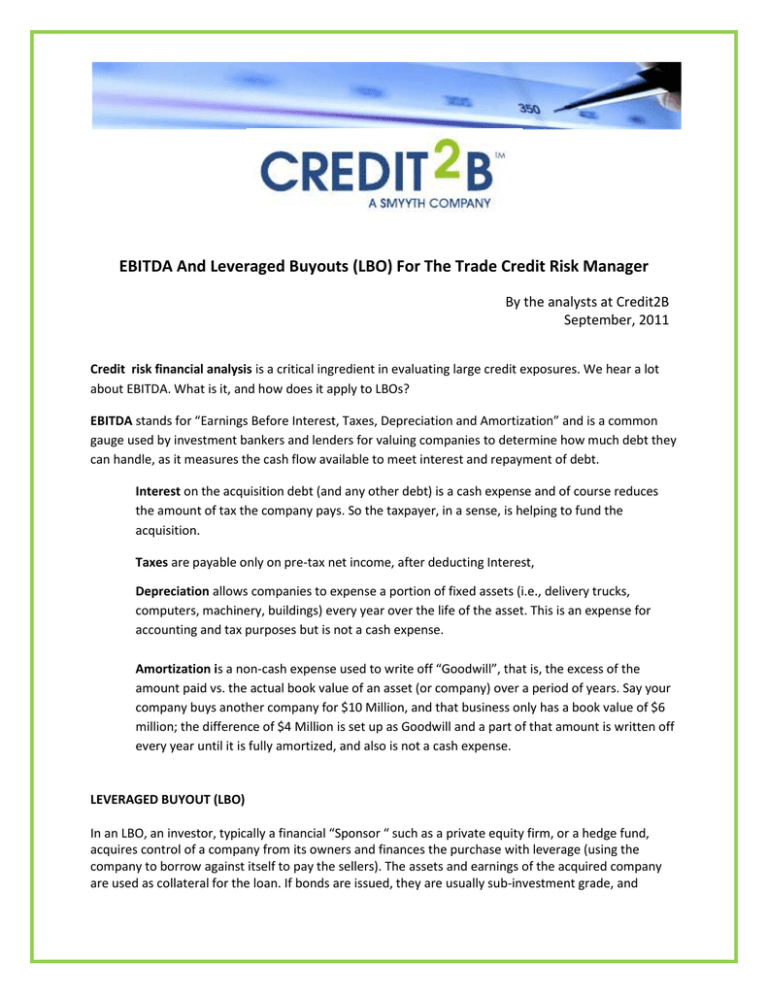
EBITDA And Leveraged Buyouts (LBO) For The Trade Credit Risk Manager By the analysts at Credit2B September, 2011 Credit risk financial analysis is a critical ingredient in evaluating large credit exposures. We hear a lot about EBITDA. What is it, and how does it apply to LBOs? EBITDA stands for “Earnings Before Interest, Taxes, Depreciation and Amortization” and is a common gauge used by investment bankers and lenders for valuing companies to determine how much debt they can handle, as it measures the cash flow available to meet interest and repayment of debt. Interest on the acquisition debt (and any other debt) is a cash expense and of course reduces the amount of tax the company pays. So the taxpayer, in a sense, is helping to fund the acquisition. Taxes are payable only on pre-tax net income, after deducting Interest, Depreciation allows companies to expense a portion of fixed assets (i.e., delivery trucks, computers, machinery, buildings) every year over the life of the asset. This is an expense for accounting and tax purposes but is not a cash expense. Amortization is a non-cash expense used to write off “Goodwill”, that is, the excess of the amount paid vs. the actual book value of an asset (or company) over a period of years. Say your company buys another company for $10 Million, and that business only has a book value of $6 million; the difference of $4 Million is set up as Goodwill and a part of that amount is written off every year until it is fully amortized, and also is not a cash expense. LEVERAGED BUYOUT (LBO) In an LBO, an investor, typically a financial “Sponsor “ such as a private equity firm, or a hedge fund, acquires control of a company from its owners and finances the purchase with leverage (using the company to borrow against itself to pay the sellers). The assets and earnings of the acquired company are used as collateral for the loan. If bonds are issued, they are usually sub-investment grade, and considered “junk” bonds. Because of the high leverage typically used, it makes these companies much riskier than before the LBO. The following factors determine if a company is a good LBO candidate. ● Pre-LBO low debt loads; ● A history of stable cash flows; ● Hard assets for collateral (property, plant and equipment, inventory, receivables); ● Potential operational or other improvements to boost cash flows and profits; ● Possibility of selling off business units to pay down debt; ● Expectation that market conditions will improve, increasing valuation in the future. Too much borrowing (remember, the buyer is buying the company with minimal cash, and mostly by borrowing), can leave a company unable to withstand downturns in its business. This financial rejiggering often leaves the firm unable to invest in its future, and has caused many ruined companies and bankruptcies. So why are LBOs so popular? It is because the Sellers get their cash, the Sponsor has the potential to make huge profits with minimal risk and little cash investment, and the Bankers make big deal fees and get higher interest rates than normal loans. So, what’s not to like? Well, when it goes wrong, which happens all too often, companies are bankrupted, trade creditors take huge losses, employees suffer with layoffs and losses of jobs, and the company is shorted funds for capital investment to keep the company competitive - you get the idea. How Much Is Too Much Debt How much can a buyer leverage the company is a function of how much predictable cash flow is available to pay down the interest and debt on the purchase, so therefore we focus on the EBITDA. The amount of Debt Coverage (see chart below) that lenders will require depends on the stability of the industry and earnings predictability of the company, also taking into consideration the company’s capital investment requirements going forward. Example: In a stable business with low capital investment needs, it might be considered that a Debt Coverage Ratio of 2.0 might be acceptable, but not so in a volatile industry, which may require a ratio of 3.0. One must always consider what happens in a bad economy, or if the company hits a bad patch. If things do not go well, there might not be much left for trade creditors after bond holders and other secured creditors are paid off. Simple Example - Pre and Post LBO Simple Cash Flow & P&L Pre LBO Post LBO Debt EBITDA Interest Expense on new debt Depreciation ( non-cash expense) Amortization (non-cash expense) Pre-Tax Profit (EBT) Taxes at 35% = Net Profit Debt Coverage (EBITDA/Interest Expense) Zero 1,000,000 (150,000) 6,000,000 1,000,000 (480,000) (150,000) (50,000) 800,000 (280,000) 520,000 (50,000) 320,000 (112,000) 208,000 2.08 Risk and Debt Coverage High debt leverage often turns a successful company into a marginal one that is much riskier for the other creditors and raises a warning flag. Both the Pre and Post LBO examples above have $1 Million of EBITDA, but when the credit manager looks deeper, he or she finds, ● The Post LBO example has $480,000 of NEW interest expense (which as every mortgage holder knows is cash that must be paid out), and has $6 million of new debt. Clearly much riskier than before. ● In this case, the LBO company’s net profit has been reduced from $520,000 to $208,000, much less of a cushion against bad times or unexpected events. ● Depreciation, while not a current cash expense, must be viewed as a real medium to longerterm expense, especially for companies that have short-lived assets, say trucks, machines, computers and stores that need frequent replacement. An analysis should be forward-looking, since reinvestment strategy and plans change, while depreciation charges reflect past expenditures, not future ones. Coverage Ratio (EBITDA /Interest Expense) Dividing the EBITDA by the Interest Expense provides a valuable indicator of a company's ability to actually carry its debt load as reflected in its Coverage Ratio. The higher the Coverage Ratio, the more able the company is to service its debt. With a higher Coverage Ratio, not only are the creditors more comfortable, but the lenders may charge lower interest rates. Conversely, interest charges often increase dramatically if the company’s EBITDA goes down, a perverse feature built into the loan covenants (the less than company can afford to pay interest, the more interest they must pay). EBITDA in Trade Credit Management In conclusion, EBITDA is something trade credit management certainly needs to understand and use to assess a business for trade credit purposes, but always keep in mind that secured debt, interest, and the taxman are always in line ahead of the trade creditor in case the business goes bad. Many LBO companies have fallen into the trap of structuring their deals during good times using toorosy predictions and too much leverage, leaving companies unable to stay afloat when business conditions turn south. The seasoned Trade Credit Manager will have seen too many failed LBOs, and tends to view them with a great deal of skepticism. The bankers seemingly have short institutional memories, going through LBO boom-bust cycles every decade or so: the high deal-fees will continue this trend. The Acquirer Risk Vs. Return If an LBO succeeds in the longer term, it can be very rewarding for the acquirer or “Sponsor” (often a “private equity” firm), who is buying a company with minimal cash or risk by borrowing against the acquired company’s own assets and earnings. Their time horizon is generally only 3-5 years in which to “create” value through financial engineering and go public or sell at a huge profit. If the company does not go public, or is not resold before the LBO debt comes due, it will have to be refinanced at that time. The Lenders Risk Vs. Return Bankers and Wall Street firms also like LBOs because they earn rich deal-fees and higher interest from these deals. They usually protect themselves by syndicating (selling off) the loan to other banks, but of course keeping the fees. Lenders and Sponsors often have cozy relationships. Conclusion - Great Vigilance Required There are many large and mid market LBO transactions, ranging from the millions to the tens of billions of dollars. Many fail - here are just a few of the largest during the last three years. The more volatile the industry (such as Retail) the more failures you will see. The period 2012-2014, with about $700 Billion of LBO re-financing coming due is a time we need great vigilance on the part of corporate credit managers. As long as (i) interest rates stay at all time lows and (ii) we do not enter a period, such as 2008-9 where there was a frantic “flight to quality”, many of these refinancings may succeed. If conditions are not good or rates are priced for risk, on the other hand, it will be an interesting and chaotic period to say the least. About Credit2BTM Credit2BTM provides world-class on-demand business credit intelligence, including reports, predictive scoring, and a peer-to-peer exchange of trade experiences on common customers. Built as a cloud-based application, Credit2BTM today delivers remarkably, high quality and timely information which is validated by a network of trusted connections. Credit2B TM is simple to join, create connections on shared customers, and access huge amounts of information from peers and third party credit bureaus through a high-fidelity experience. Please visit www.credit2b.com for more information about Credit2BTM products and services.


